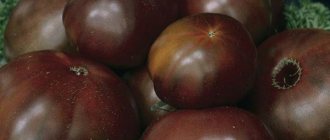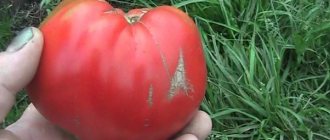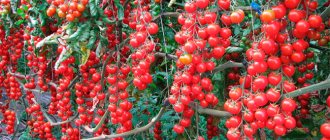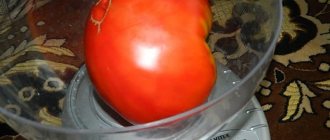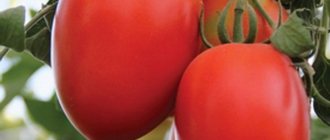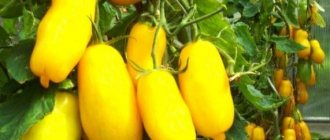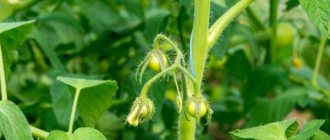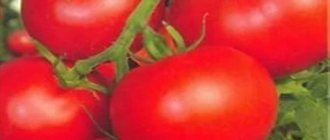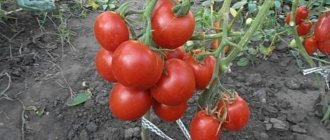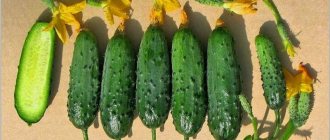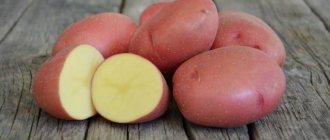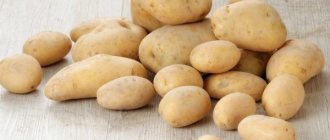Home / Vegetable garden / Tomatoes
Back
Published: 11/07/2020
Reading time: 21 minutes
2
Persimmon tomatoes got their name because of their amazing external resemblance to the famous fruit - the famous “food of the gods”. Unlike real persimmons, which have astringent properties when unripe, the tomato is sweet and tasty.
Those who planted the variety are satisfied with the large fruits and taste of tomatoes, although the plants require attention and care. Seeds from various manufacturers are available for sale, but the fruits, yields, and taste characteristics differ significantly. We offer a detailed description of the variety according to the State Register catalog, recommendations on agricultural technology for “real persimmons,” and reviews from summer residents who have received the harvest.
- 1 Description
- 2 Characteristics of fruits
- 3 Comparison with other yellow-fruited tomatoes
- 4 Advantages and disadvantages
- 5 Features of agricultural technology of large-fruited varieties 5.1 Preparation and cultivation of seedlings
- 5.2 Care: basic measures
Description and characteristics of the variety
- Determinate, mid-season hybrid. From the emergence of seedlings to the ripening of the first fruits, 90-105 days pass.
- A medium-sized variety, it grows up to 70-90 cm when grown in open ground, in greenhouse conditions it can stretch up to 120-140 cm, then the bushes need to be tied up.
- The stems are powerful. The bush grows a lot of bright, light green foliage.
- Mature bushes with a large number of fruits need a garter.
- The inflorescences are simple. The first ovaries are formed after 6-7 leaves, the subsequent ones - after every 1-2 leaves.
- Each cluster produces 3-4 fruits.
- It bears fruit from July; when sowing seeds for seedlings in March, the fruits appear within 5 months, almost until frost.
- The average weight of tomatoes is 240-350 g. Some specimens can grow up to 500 g. The largest Persimmon tomato weighs 700 g.
- The tomatoes are beautiful in appearance, bright orange and golden. They have a round shape, slightly flattened. They resemble persimmons in appearance, after which they are named.
- At first, a green spot is visible on the tomatoes, which disappears when the fruit ripens.
- The pulp is juicy, sweet, orange in color. An overripe tomato acquires a slight sourness.
- 4-6 kg of fruits are collected from one bush.
- Dry matter content 4-6%.
- A tomato has 6-8 chambers. The seeds are small and there are few of them.
- The skin is dense, does not crack during heat treatment and retains its appearance.
Care after transplant
Growing Persimmon variety tomatoes requires compliance with agricultural technology after replanting, regardless of whether the bushes grow in a greenhouse or without shelter. This type of tomato requires normal watering, fertilization, and mandatory pinching.
Persimmons must be attached to a support, since massive fruits can break weak shoots. In addition, low resistance to insects and infections makes preventive spraying necessary.
In the greenhouse
Persimmon tomatoes grow well in greenhouse conditions, reaching a height of 100-140 cm. Seeds for seedlings can be sown as early as February, and replanted in April. Caring for tomatoes growing in warm conditions has its own nuances:
- The soil mixture should contain equal parts of humus and turf, as well as some sand and wood ash.
- If the penetration of sunlight is weak, you need to equip the greenhouse with additional lighting.
- Constant air temperature should not fall below 20°C, optimally 22-25°C.
- The bushes must be tied to a support.
In the open ground
Growing Persimmon tomatoes in open ground is possible only in the southern regions, where the climate allows the plants to receive sufficient heat and light during the growing season. Attention should be paid to the following nuances of care:
- Seedlings must be hardened off and planted only if there are no night frosts in the forecast.
- Fruit shoots must be pinched.
- In the absence of protection from external factors, it is necessary to carry out preventive treatment of tomatoes of the Persimmon variety against pests and diseases.
Shaping and garter
Regular pinching is extremely important for the formation of Persimmon bushes of the correct type. To increase productivity, the plant must have 2-3 shoots. Therefore, during the growth period, up to 2 lower stepsons must be preserved on the stems and the rest removed. In case of intensive vegetation and thickening, the procedure must be repeated.
With the active growth of tomatoes in height, Persimmon needs a garter. As a support you can use:
- pegs at a distance of 10 cm from the stem;
- trellises located along the rows;
- top guides of greenhouses.
The plants are attached to the support carefully so that the knots of the twine or clip do not pinch the tomato stem.
Diseases and pests
The weak immunity of the Persimmon variety makes the tomato susceptible to many diseases:
- Viral infections. Viruses are transmitted by pests; the drug Fitolavin is used to prevent and treat the disease.
- Necrosis. Disinfection of soil and seeds prevents plants from dying, but if this procedure has not been carried out, the affected plants can only be dug up and burned.
- Late blight on tomatoes. A dangerous fungal disease affects yellow tomatoes due to waterlogging of the soil, wet weather or the proximity of weeds. It is important to quickly respond to infection and remove diseased plants.
- Microsporiasis. A fungal infection develops at temperatures above 23°C and leads to rotting or drying out of the green part of the plant. Prevention with preparations containing copper will prevent infection of vegetables.
Among garden pests, Persimmon tomatoes attract:
- slugs;
- wireworm;
- whitefly butterflies.
The crop will be reliably protected from insects and diseases by proper care after transplanting seedlings, timely treatment of tomatoes with insecticides and fungicides, as well as compliance with watering standards and weeding.
Watering
It is enough to water Persimmon tomatoes once a week. In dry weather, you can increase the number of waterings to 2, but you can slightly reduce the volume of water by applying it at the root. Moisture should be added in the morning or evening, when the tomatoes are not in direct sunlight. In a greenhouse, it is enough to water Persimmon once every 3-5 days, or use a drip irrigation system. It is recommended to accompany soil moisture by loosening to provide the roots with moisture and oxygen.
Feeding
The Persimmon variety requires additional fertilization during the growing season. Tomatoes are fed with an aqueous solution of ammonium nitrate, potassium chloride and superphosphate. The timing of additional nutrition depends on the growth phase:
- 1-2 weeks after planting seedlings;
- until 3 fruit clusters are formed;
- during the ripening period of tomatoes.
If the greenery is growing too actively, less nitrate is added, and to speed up fruiting, more potassium and phosphorus are added.
Productivity
The yield of the variety depends on the growing conditions:
- When grown in a greenhouse, you can harvest about 6 kg from one bush.
- In open ground, one bush produces up to 4 kg of tomatoes.
According to reviews from many gardeners who grow Persimmon tomatoes in greenhouses, with proper care, up to 9 kg of ripe, juicy fruits can be harvested from 1 m2 of soil.
Important! To speed up the ripening of Persimmon tomatoes, it is recommended to pinch the bushes 3-4 weeks before the arrival of cold weather.
Features of planting and care
Tomatoes of the “Persimmon” variety, photos of which are presented below, are ideal for growing in the southern regions: the North Caucasus and the Astrakhan region. If planting is planned in such latitudes, then seedling preparation is not necessary.
Seeds are sown directly into the bed under the film. They have a high germination rate of 90%. The optimal temperature for germination is +23–26°C.
Before planting in the ground, you need to make sure that there will be no more frosts. Recommended time is the second half of May.
Attention! This variety is not recommended for those who are just learning the rules of agricultural technology. “Persimmon” requires that all actions be completed on time.
Errors in care can lead to low yields. The bushes grow more than 1 m in height; they must be tied up so that the stems do not break under the weight of the fruit.
Particular attention should be paid to the watering regime. Moisturize in the evening with water heated in the sun. The soil should not dry out, but at the same time, excess moisture will lead to rotting of the tomato root system. Tomatoes require watering immediately after flowering.
If tomatoes grow in open ground, they need to be fed with mineral fertilizers. In the greenhouse, the soil should be mixed with a small amount of river pech, humus, peat and coconut substrate. These components will make the soil loose and moderately acidic.
Photo of tomato Persimmon
You can see the fruits of the Persimmon tomato variety in the photo
Advantages
- The main advantage of the Persimmon variety is its large fruits, some of which can reach 500 g.
- Contains a large amount of carotene and virtually no organic acids. These tomatoes are ideal to include in your diet.
- Can be grown in greenhouses, greenhouses, and open ground.
- High seed germination rate - 90%, which gardeners really like.
- Tomatoes can be harvested unripe; they ripen perfectly outside the bush, while maintaining all their qualities.
- Resistant to transportation and storage, do not lose their appearance.
Advice! The harvest is better and more abundant when grown in unheated greenhouses and greenhouses than in open ground.
Flaws
Among the disadvantages are the following:
- Requires careful care.
- Not resistant to tomato diseases, especially late blight.
- The need to garter the bushes so that large fruits that pull the plant to the ground do not lead to its breaking.
- Regular watering and temperature conditions are required (tomatoes do not like heat).
- Reacts negatively to the content of potassium and calcium in the soil.
Important! Unripe Persimmon tomatoes have a green spot in the area of the stalk, which disappears when the fruit is fully ripened.
Diseases and pests
Persimmon is a sickly tomato. Common enemies:
- phytosporosis;
- slugs;
- wireworm;
- whitefly;
- infectious, inflammatory and fungal diseases are typical for tomatoes.
To protect the bush, you need to do the following:
- Pay special attention to weeding, watering and fertilizing. It is recommended to spray the plant with special solutions for prevention.
- When the first signs of illness are detected, take emergency measures. For example, it is important to separate healthy leaves and brushes from diseased ones and spray them with “medicines.”
- The following drugs will help against pests: Baduzin, Confidor. While loosening the soil, you can spray 1 tsp. hot pepper or ash around the bush.
When the first foci of disease are detected, fungicides are used. A small number of pests can be eliminated using folk remedies. If the invasion is massive, then you have to purchase insecticides.
Features of cultivation
Seeds for seedlings are planted in early March. Tomato seedlings of the Persimmon variety are planted when more than 6 true leaves appear and the height reaches 15 cm or more.
Bushes are planted 3-4 per 1 m2, no more. It must be remembered that the likelihood of developing various diseases increases with thickening of the planting.
More information about growing tomatoes is described in the article: Technology of growing tomatoes. Secrets of planting and care.
You might be interested in: How to properly plant tomatoes in a greenhouse: bush formation diagram, care features, photos and videos
Useful information: How to properly tie tomatoes in open ground: the best methods, step-by-step photo and video instructions
How to grow seedlings
Growing healthy and strong seedlings is extremely important, since the future health and productivity of the plant depends on it. Let's consider the features of cultivation at the initial stage.
Seed preparation
To make the seeds germinate faster, soak them. Before planting, cover the seeds with warm water and leave for 1-2 hours. Seeds that float are unsuitable for planting. The rest can be safely used.
Advice . It is useful to add a little potassium permanganate to the water when soaking. This will disinfect the seeds and avoid the development of diseases in the future.
Soaking in growth stimulants (for example, “Baikal”, “Epin Extra”, “Zircon”) helps to increase resistance to various diseases.
Container and soil
Tomatoes prefer slightly acidic, closer to neutral soil of 5-6 pH.
For planting, use ready-made universal substrates or prepare the mixture yourself: mix sand, peat and soil in equal proportions. The disinfection mixture prepared independently is calcined in the oven and spilled with a solution of potassium permanganate.
In the process of growing seedlings, you will need two types of containers:
- a low container or box for planting seeds for germination. For these purposes, ordinary food containers or a wooden box covered with film are suitable. Don't forget to provide drainage holes;
- individual containers for growing plants after picking. Hardware stores offer a large assortment of ready-made containers for growing. Or use food-grade plastic cups and other containers convenient for you.
Sowing
Sowing of seeds is carried out 50-60 days before the plant is supposed to be planted in the ground or greenhouse. The seeds are placed in moist soil to a depth of 1-1.5 cm. To reduce moisture evaporation, the container is covered with film.
After the first seeds germinate, the film is removed. The optimal temperature for keeping sprouts varies in the range of 20-24 degrees.
Growing and care
After 1-2 leaves have opened on the sprouts (after about 15-20 days), the seedlings are picked. The seedling is buried in the ground up to the cotyledon leaves. A few days after transplantation, when the plant adapts a little to the new conditions, the night temperature is gradually reduced to +18 degrees.
Water the seedlings moderately, in the morning, with lukewarm water. Excess moisture is dangerous for the plant by developing diseases.
Once every 2-3 weeks, fertilize with potassium and phosphorus.
